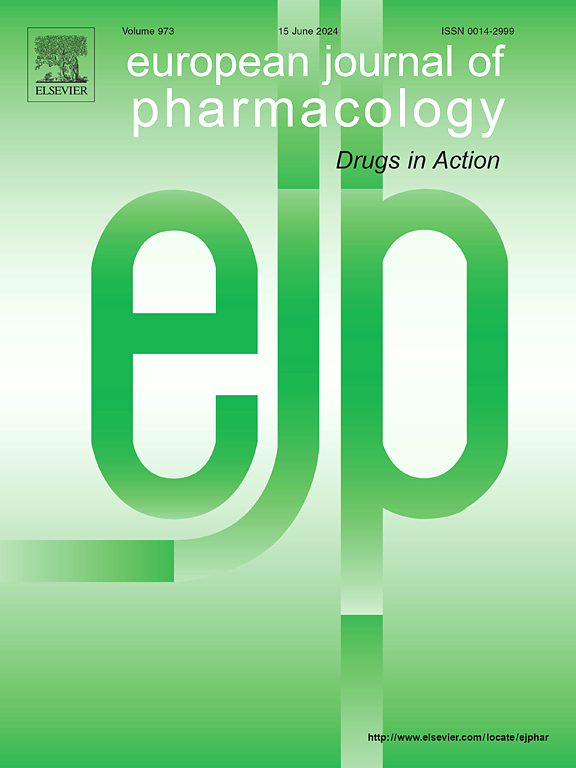毛蕊异黄酮通过NLRP3炎性体治疗急性心肌梗死:生物信息学、网络药理学及实验验证
IF 4.2
3区 医学
Q1 PHARMACOLOGY & PHARMACY
引用次数: 0
摘要
背景萼萼霉素(CA)是一种黄酮类天然产物,可有效治疗急性心肌梗死(AMI),但其机制尚不清楚。方法利用GEO数据库、SwissTargetPrediction、PharmMapper和文献检索确定了与AMI和CA相关的靶点。利用蛋白质-蛋白质相互作用分析和Cytoscape筛选出治疗AMI的CA核心靶点。富集分析确定了与AMI相关的生物通路以及CA的潜在机制。免疫浸润分析用于探讨免疫细胞在 AMI 中的作用以及核心靶点与免疫细胞之间的相关性。结果生物信息学发现了AMI的相关靶点和生物学机制,网络药理学发现了31个受CA影响的潜在靶点,其中NLRP3、IL-18、IL-1β、MMP9和TLR4为核心靶点。富集分析表明了这些潜在靶点的生物学作用,并选择了NLRP3、IL1β和IL18作进一步分析。免疫浸润分析表明,NLRP3和IL-1β与单核细胞、肥大细胞活化和中性粒细胞密切相关,而IL-18与单核细胞密切相关。CA通过抑制NLRP3炎性体活化、降低IL-18和IL-1β水平,对AMI大鼠的心脏起到保护作用,从而改善心功能,减轻心肌损伤和纤维化。本文章由计算机程序翻译,如有差异,请以英文原文为准。
Calycosin treats acute myocardial infarction via NLRP3 inflammasome: Bioinformatics, network pharmacology and experimental validation
Background
Calycosin (CA) is a flavonoid natural product that may effectively treats acute myocardial infarction (AMI), but its mechanism is unclear.
Methods
Targets related to AMI and CA were identified using the GEO database, SwissTargetPrediction, PharmMapper and literature searches. Protein-protein interactions analysis and Cytoscape were used to screen the core targets of CA for AMI treatment. Enrichment analysis identified biological pathways linked to AMI and potential mechanisms of CA. Immune infiltration analysis was used to explore the role of immune cells in AMI and the correlation between core targets and immune cells. And further validated in AMI rats with ligated left anterior descending.
Results
Bioinformatics identified relevant targets and biological mechanisms of AMI, and network pharmacology revealed 31 potential targets affected by CA, with NLRP3, IL-18, IL-1β, MMP9, and TLR4 as core targets. Enrichment analysis demonstrated the biological roles of these potential targets and NLRP3, IL1β and IL18 were selected for further analysis. Immune infiltration analysis showed that both NLRP3 and IL-1β were closely associated with monocytes, mast cells activated and neutrophils, and IL-18 was closely associated with monocytes. CA exerted cardioprotective effects in AMI rats by inhibiting NLRP3 inflammasome activation and reducing IL-18 and IL-1β levels, improving cardiac function and attenuating myocardial injury and fibrosis.
Conclusion
CA effectively protects cardiac function and mitigates myocardial injury in post-AMI rats, probably through NLRP3 inflammasome inhibition.
求助全文
通过发布文献求助,成功后即可免费获取论文全文。
去求助
来源期刊
CiteScore
9.00
自引率
0.00%
发文量
572
审稿时长
34 days
期刊介绍:
The European Journal of Pharmacology publishes research papers covering all aspects of experimental pharmacology with focus on the mechanism of action of structurally identified compounds affecting biological systems.
The scope includes:
Behavioural pharmacology
Neuropharmacology and analgesia
Cardiovascular pharmacology
Pulmonary, gastrointestinal and urogenital pharmacology
Endocrine pharmacology
Immunopharmacology and inflammation
Molecular and cellular pharmacology
Regenerative pharmacology
Biologicals and biotherapeutics
Translational pharmacology
Nutriceutical pharmacology.

 求助内容:
求助内容: 应助结果提醒方式:
应助结果提醒方式:


